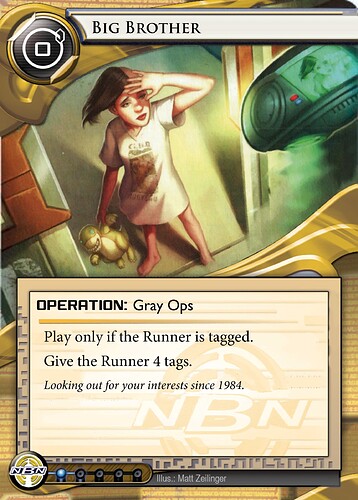inhales deeply for a full 47 seconds…
As the person who ran the balance team from 2018 to 2021, I probably had more people allcaps at me to ban it than anyone else in the community. 
My thoughts on it are big and complicated and I won’t go over them all in here. Personally, I love the play patterns HHN creates, especially the ability to create tense forks for the runner. But I’ve seen enough newbies and casual players ragequit at the first HHN being played to understand that those play patterns are counterintuitive to someone who’s been playing in a card pool without HHN until now (eg Startup players, or core-only players in the FFG days).
I’ve also talked a lot with people on GLC who’ve been turned off Standard by its existence, and decided to stick with Startup permanently. One of the most frequent complaints about it is that it draws out the process of losing the game. In other words, it makes people feel like they’re dead, but they have to wait another 2-5 turns for the corp to find enough tag punishment to finish the job (whether that’s a psycho or a boom). This was brought up both by people who started playing with Gateway, and by people who played early in the FFG days (before Flashpoint) and recently came back.
In my own personal observations, more casual players rarely know how to respond to an HHN. They don’t know when it’s correct to turtle up and try to clear tags over several turns or when to just decide to go tag-me. They don’t know how to manage their economy while tagged to protect themselves from a Market Forces. And Gaslight made it even harder to know exactly where to run to prevent yourself from losing next turn. Of course, to me these are fun and interesting situations. But they’re situations that I learned alongside everyone else, because I was around when the card first came out and we were all figuring out how to deal with it. A newcomer is being pitted against people who are playing it pretty much optimally, and they have the added disadvantage of not knowing the card pool well enough to know what kind of tag punishment to expect following an HHN, and how many credits the corp needs to be on to play them.
This has made me question the prevailing view among both the community and the designers of the game that tag punishment should be more granular. Gating victory behind multiple tags just draws out a losing position in a way that is anti-fun from the point of view of someone who hasn’t learned the correct lines to get out from that position. And making low-tag punishment weaker just means that the Corp has to chip away at the runner and HHN them over and over again before they can finally seal the deal. Strong single-tag punishment like Scorched or Exchange of Information meant that you could clear all but one tag and the game could still end a turn later. Nowadays there’s practically nothing I’d slot into a tagging deck that doesn’t need 2+ tags to be effective, making the game grindier and forcing the losing side to stay in a subjectively unfun position longer. I know that more granular tag punishment has been a growing trend in the game all the way since this card was release (in the same cycle as Boom!), but I think the natural progression of that trend has been negative both for onboarding new players and by ensuring that the strongest tag-based corps are prison decks.
You’ll notice this isn’t even my thoughts on HHN itself, but rather on the design direction of the game as a whole. This just goes to show what a defining card HHN is, that thinking about it means thinking about the whole concept of tags in Netrunner. It was a very special card, one of Damon’s greatest gifts to us, and I’ll always be very fond of it, but I think it’s overstayed its welcome.
